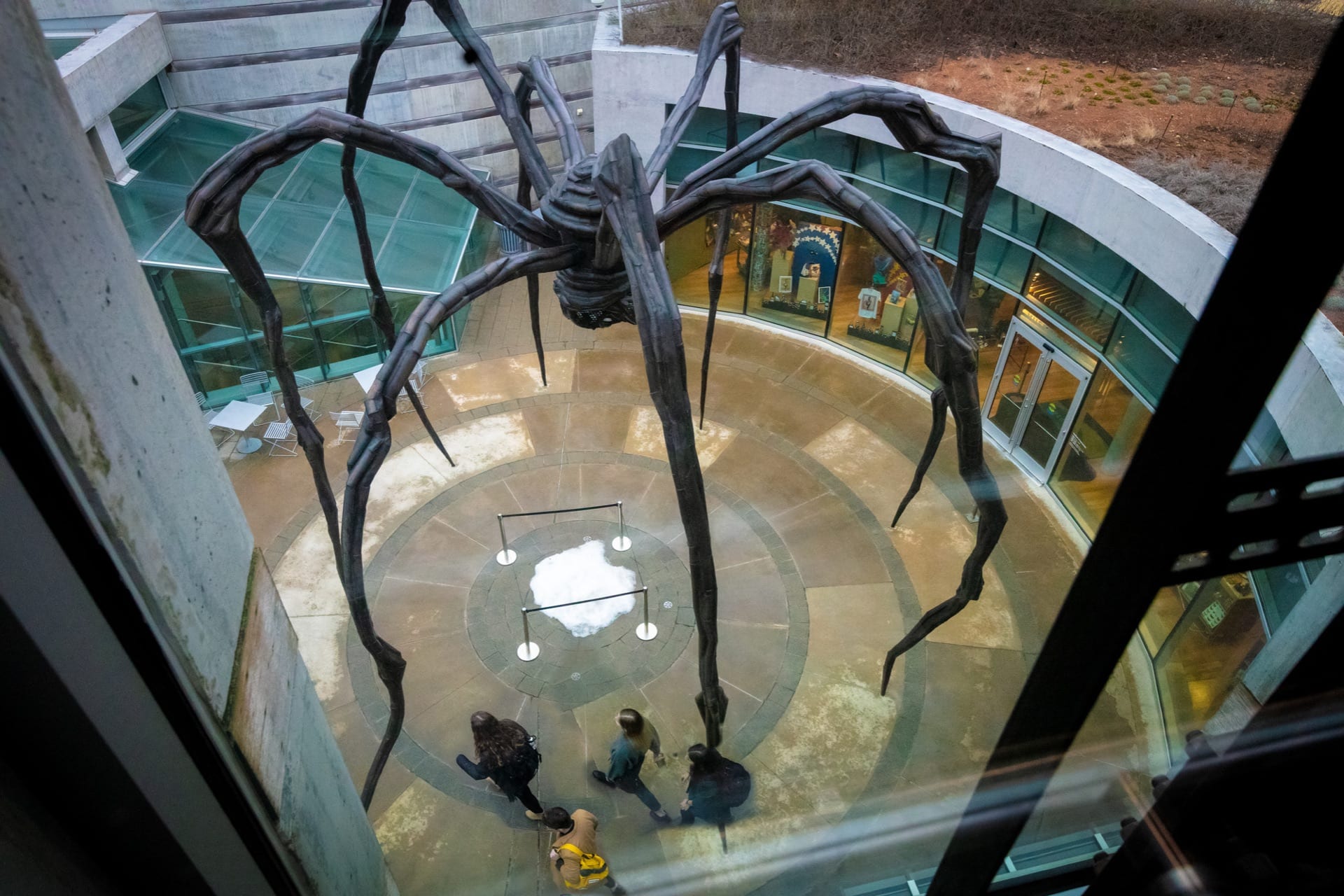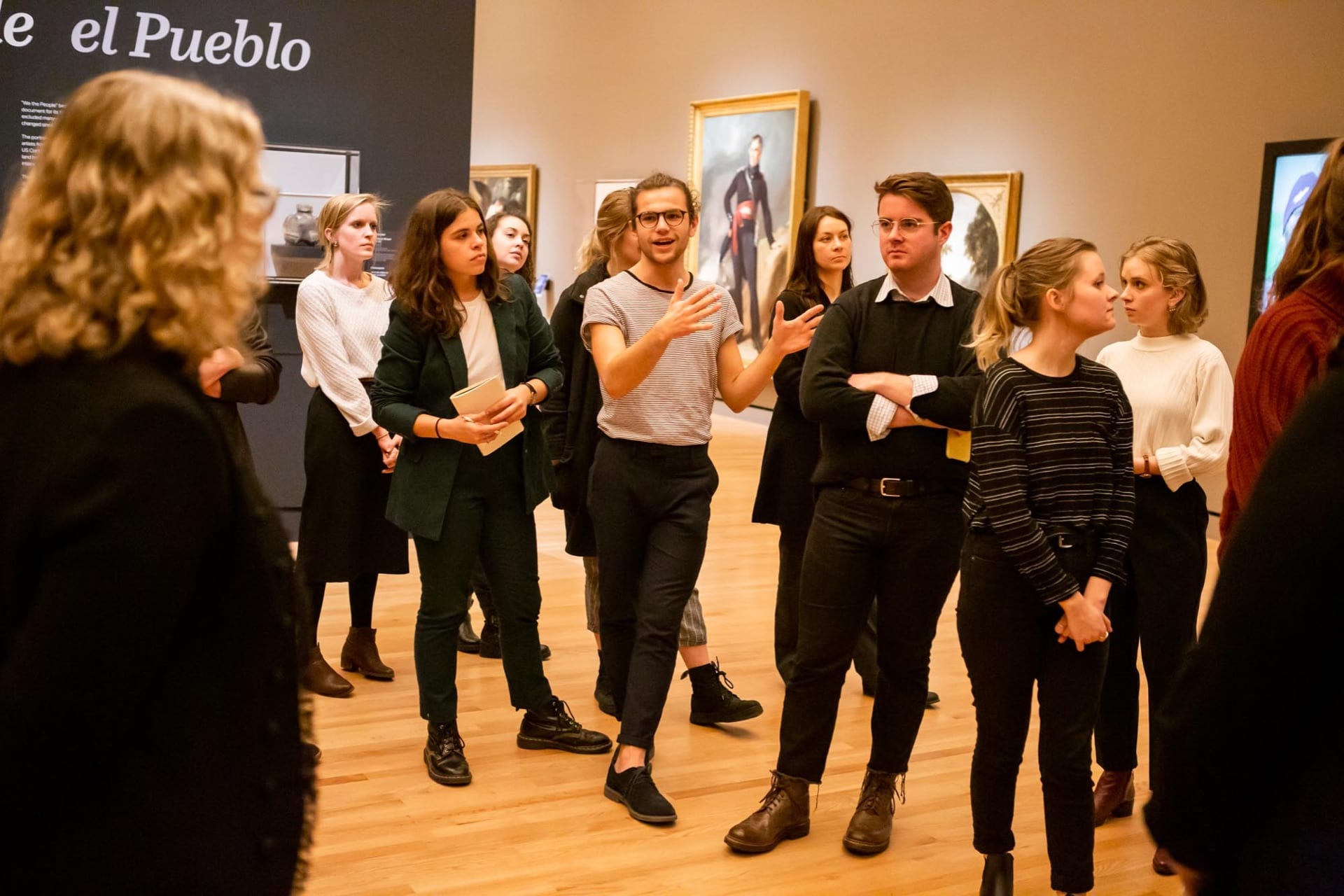
Students in the Museum course stride under Louise Bourgeois’ Maman toward the entrance to Crystal Bridges Museum of American Art.
In this post, “Museum” participant Max Frank dissects just what makes a satisfying customer experience at Crystal Bridges Museum of American Art. One thing he learned: it all starts at the entrance. Max Frank is a second-year honors landscape architecture student at the University of Arkansas. Originally from Billings, Montana, Max has found a home in Fayetteville, and is involved in the ecology and the arts communities both on and off campus. He has designed and installed a temporary installation on campus as a part of the Place in Mind team, spawned by an Honors College Signature Seminar, and is looking toward international experience in both France and Mozambique in 2019, exploring design and fabrication in these cultures. After graduation, Max is looking toward graduate school and a career in design advocacy.
What is the best customer service experience you’ve ever had?
What is the worst?
These two questions provided a framework for our museum investigation this week. We spent our time at the museum drilling deep into the subject of guest experience with Jill Wagar, Chief Strategy Officer, and Scott Eccleston, Director of Operations. Wagar and Eccleston both lead the teams that engage the vast majority of Crystal Bridges visitors, so these questions about guest experience are rarely not on their mind. We quickly started to understand that user experience is not just about one interaction or moment but involves an incredibly complex choreography of experiences that can start in the parking lot and end on the drive home.
So, what exactly are these elements that make up a guest experience? Are they the spaces you inhabit, the people you talk to, the objects you see? Turns out, they are all of the above! In order to witness these first-hand, we took a direct look at the museum itself, and broke down what was working, as well as what wasn’t. We met by the front doors to dissect the arrival experience at the museum. After parking, taking an elevator, and experiencing an unexpected (and potentially jarring) greeting from Louise Bourgeois’ Maman, museum visitors finally arrive at the front door. What happens next could be one of the best or worst parts of their entire visit, so every detail must be considered.
 This image shows some of the mixed messages one may receive upon arriving for the first time. A banner of welcome targets the eye, yet after the vaguely brutalist sequence of parking garage, concrete elevator tower, and giant bronze spider, not everyone may be convinced. We discussed the need for an opportunity to orient and decompress at this stage in the entry sequence: A time to simply take a deep breath, savor the drama, and move forward with the adventure! Unfortunately, many visitors are unable to do so in this space, whether unsettled by arachnophobia, exhaustion, or simply not knowing where to go. Thankfully, Wagar and Eccleston have something in store to combat these challenges.
This image shows some of the mixed messages one may receive upon arriving for the first time. A banner of welcome targets the eye, yet after the vaguely brutalist sequence of parking garage, concrete elevator tower, and giant bronze spider, not everyone may be convinced. We discussed the need for an opportunity to orient and decompress at this stage in the entry sequence: A time to simply take a deep breath, savor the drama, and move forward with the adventure! Unfortunately, many visitors are unable to do so in this space, whether unsettled by arachnophobia, exhaustion, or simply not knowing where to go. Thankfully, Wagar and Eccleston have something in store to combat these challenges.
Most likely, at this point in the visit, a Crystal Bridges team member will warmly greet the guest, offering advice, wayfinding, or just general assistance. Wagar and Eccleston believe that by going the extra mile in team trainings, they can create meaningful experiences by teaching team members to respond nimbly and effectively to all kinds of situations. Especially at a museum whose visitors are diverse in age, ability and interest, not taking a “one size fits all” approach to guest experience is a major undertaking. But according to industry research, it makes all the difference.
Culture Track, a study by LaPlaca Cohen, breaks down the public’s attitudes on culture. What is it, how do we engage with it, and what makes it desirable? Personally, the biggest takeaway was that now more than ever, people’s ideas of culture vary tremendously, as do the types of experiences they seek. Crystal Bridges takes this type of research very seriously and conducted their own study about how their guests engage with the museum: the GEMS Report. They break down their users into five key groups: Experience Seekers, Explorers, Rechargers, Facilitators, and Professionals/Hobbyists, and identify likely demographics for each. The only catch: these groups want vastly different experiences. Some see going to a museum as an incredibly social experience, a chance to bond with others and celebrate community, while others are looking for a peaceful moment of respite and would prefer limited or no social activity.
Managing these differences is a serious and difficult challenge, but one that sets Crystal Bridges apart as an institution. Furthermore, many other museums are beginning to channel this type of guest engagement, contributing to rich, diverse experiences and a newly emerging museum culture.

